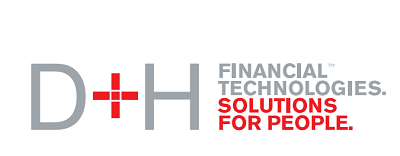D+H is a financial technology provider that works to improve financial institutions as they move into the modern era of digitized economy. One of the firms main goals is to integrate blockchain technology into the finance industry, streamlining services and making them stronger. In fact D+H executive vice president of Global Pre-Sales Moti Porath believes that the blockchain — more specifically, private blockchains — could be the biggest thing in finance since electronic trading.
Also read: Joint Biometric Security Collaboration Aims to Protect Financial Services
D+H for Private Blockchains
 However, Porath and the D+H team do not think that the blockchain is perfect in its current state. The ecosystem faces many hurdles, namely a crowded Bitcoin industry with growing amounts of regulation, and a blockchain scalability issue that can’t seem to get solved. According to a white paper released by D+H, “the Bitcoin ecosystem is as crowded and diverse and almost as regulated as the money ecosystem it was intended to replace,” and that the blockchain is too slow and doesn’t have enough capacity to “use it to wire up a whole institution, country or global marketplace.”
However, Porath and the D+H team do not think that the blockchain is perfect in its current state. The ecosystem faces many hurdles, namely a crowded Bitcoin industry with growing amounts of regulation, and a blockchain scalability issue that can’t seem to get solved. According to a white paper released by D+H, “the Bitcoin ecosystem is as crowded and diverse and almost as regulated as the money ecosystem it was intended to replace,” and that the blockchain is too slow and doesn’t have enough capacity to “use it to wire up a whole institution, country or global marketplace.”
With these issues in mind, Porath thinks that there are five major goalposts that blockchain technology has to reach in order to be viable for mainstream financial use:
- Find the right problem
- Emerge with a dominant technology
- Retain its disruptive potential despite regulatory requirements
- Scale up to handle the volumes and speeds required by the financial industry
- Align its evolution with banks’ timescales and perspective
D+H wants to help the technology progress and achieve these necessary milestones through ditching permission-less blockchains and building strong private blockchains. This model might rub a lot of Bitcoiners the wrong way; the “anyone can join” mentality of the Bitcoin blockchain is what makes the Bitcoin ecosystem unique, with its wide range of block-chain based applications and businesses. The decentralized nature of permission-less blockchains also preserve financial freedom in theory, ideally keeping any one person or group from controlling the network.
I got the chance to ask Porath questions about D+H’s vision of private blockchains. The executive vice president took this opportunity to make the case for private blockchains, detailing the ways in which D+H can bring our favorite technology to the mainstream.
What exactly is D+H and what is it doing to achieve these 5 goalposts it has set for the blockchain technology’s success?
D+H is a leading financial technology provider that creates solutions that the world’s financial institutions rely on to help them grow and succeed, every day. Our core, lending, payments, treasury services and delivery channel solutions help our clients expand market share and improve financial performance; achieve compliance and risk control; improve operational scale and efficiency; and enhance their customer’s experience.
We are the first provider of a global payment services hub to integrate blockchain distributed ledger technology into our solution to enable financial institutions to utilize a secure, closed loop distributed ledger system to connect bank networks, move money in real-time, and improve access to liquidity. Using the solution, peer-to-peer payments can be made in real-time, benefitting from the anonymity inherent in blockchain technology to ensure security and reduce risk.
However, we also recognize that we are at an inflexion [sic] point – and in our view, all progressive banks must be prepared to respond now if they’re to avoid getting left behind in the race to turn the promise of blockchain into reality. To help banks take the right steps, we have written a white paper to showcase five things that must be gotten right for blockchain to realize its promise, and enable banks to capitalize fully on what could be the most significant development in financial services since the advent of the internet.
What’s wrong with the current state of the Bitcoin ecosystem?
Bitcoin has many proponents and detractors, and we will leave it for them to argue about the state of the Bitcoin ecosystem. As technologists and payments experts, we see the promise in Bitcoin’s underlying blockchain distributed ledger technology.
Are people who think that Bitcoin will take over the world naive?
Again, our focus is on the underlying blockchain technology and its transformative potential on the payments space.
Explain how regulation is affecting Bitcoin and the blockchain technology, even though they are not directly regulated themselves.
Although Bitcoin and blockchain are not regulated in themselves, many participants in the ecosystem – banks and stock exchanges, for example – are subject to substantial regulation. This in turn imposes a certain level of regulation on the overall solution, with regulators taking a close interest in its integrity and resilience.
What is your opinion on banking regulation, how has it set the stage for blockchain technology?
It is the responsibility of block chain solution providers to make sure that regulations such as KYC and sanctions are adhered to within any block chain framework
Can you think of any other areas of finance other than loan syndication where the blockchain can “find the right problem”?
In our view, payments is one of the most significant areas within a bank best positioned to benefit from the transformational potential of blockchain. As our focus is payments, we see the value that blockchain capabilities bring to how payments are made and settled. D+H has made significant investments in blockchain and distributed ledger innovation, and will continue to explore new use cases and other opportunities for the technology.
Is it really possible for blockchain to be integrated into mainstream markets without reforming standing regulation? Wouldn’t the necessary changes to comply with existing laws essentially defeat the purpose of blockchain technology? I’m thinking of the BitLicense, based on normal banking codes, and how it strips things like privacy from Bitcoin-centric companies.
It’s widely agreed that permission-less blockchain – “anyone can join” – will not work in a regulated industry. The existing industry utilities such as SWIFT and Fedwire are inherently membership based or “permissioned” to keep out bad actors and sanctioned entities.
Other industry and regulatory factors also need to be incorporated into blockchain solutions. Like a well-designed car, all aspects of a bank’s operations need to work together, and changing one aspect may have unintended impacts on others – a risk that banks must guard against.
With regulatory frameworks for blockchain still at an embryonic stage of development, the challenge for regulators and market participants is to work together proactively to define the best supervisory models and approaches. Experience suggests that most
regulators are open to discussing use cases for blockchain and providing guidance on the regulatory aspects. Indeed, blockchain promises some benefits for regulators around transparency and visibility, provided their open access complies with privacy regulations for everyone else.
However, while regulators are unlikely to tolerate fully permission-less solutions, making them permissioned chips away at blockchain’s overall promise, making it important to ensure the technology isn’t overly stifled by rules and regulations.
The 4th point about scalability doesn’t mention Bitcoin’s block size issue, but it is certainly implied. Do you have an opinion on the current solutions available for the block size problem?
Private block chain eliminate the concerns regarding block size. Once the proof of work is eliminated the block size problem can be easily managed
In the 5th point, what was meant by the concepts of “failing fast” and “pivoting,” and why are they not conducive to long-term stability?
What we meant to say is that in order for block chain to become part of banks core technology and operational infrastructure. It will require long term vision and thinking to successfully incorporate block chain as part of banks core. It requires cooperation between technology, business, security, risk, and operations to attain the long term sustainability MA acceptance across the entire banking and FI enterprise.
What do you think about private blockchains? Let us know in the comments below!
Images courtesy of D+H









